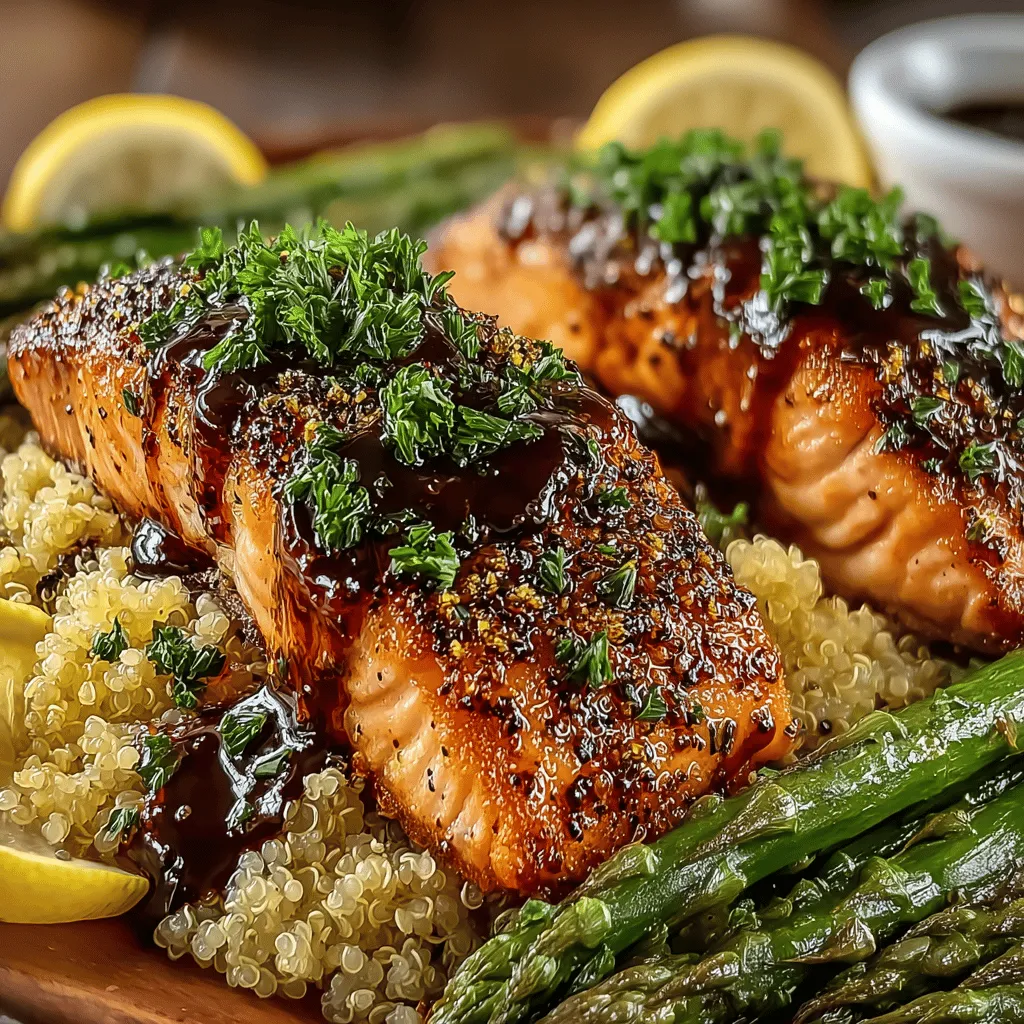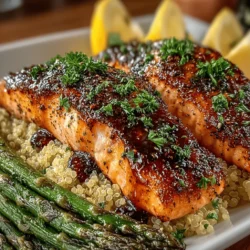Introduction
Discover the vibrant flavors of Zesty Lemon Pepper Salmon with Quinoa and Asparagus, a dish that combines the richness of salmon with the wholesome goodness of quinoa and the crisp freshness of asparagus. This recipe not only dazzles the palate but also packs a nutritional punch, making it perfect for a hearty weeknight dinner or an impressive meal for guests. In this article, we will explore the benefits of each ingredient, provide detailed cooking instructions, and delve into the nutritional value of this delightful dish.
Ingredients
– 4 salmon fillets
– 1 cup quinoa
– 2 cups vegetable broth (for cooking quinoa)
– 1 bunch of asparagus, trimmed
– 2 tablespoons olive oil
– Juice and zest of 1 lemon
– 1 teaspoon black pepper
– 1 teaspoon sea salt
– 1 teaspoon garlic powder
– Fresh parsley, chopped (for garnish)
Instructions
1. Preheat your oven to 400°F (200°C).
2. Rinse the quinoa under cold water to remove saponins, which can give it a bitter taste.
3. In a medium saucepan, combine the rinsed quinoa and vegetable broth. Bring to a boil, then reduce the heat to low, cover, and simmer for about 15 minutes or until the quinoa is fluffy and all the liquid is absorbed.
4. While the quinoa cooks, prepare the marinade for the salmon. In a small bowl, mix together olive oil, lemon juice, lemon zest, black pepper, sea salt, and garlic powder.
5. Place the salmon fillets in a shallow dish and pour the marinade over them. Let the salmon marinate for at least 15 minutes to absorb the flavors.
6. While the salmon is marinating, arrange the trimmed asparagus on a baking sheet. Drizzle with olive oil and sprinkle with sea salt and black pepper.
7. Roast the asparagus in the preheated oven for about 10-12 minutes, or until tender and slightly crispy.
8. After the asparagus has been in the oven for about 5 minutes, place the marinated salmon fillets on a separate baking sheet lined with parchment paper.
9. Bake the salmon for 12-15 minutes, or until it flakes easily with a fork and has a nice golden color.
10. Once everything is cooked, fluff the quinoa with a fork and season it lightly with salt if desired. Serve the salmon over a bed of quinoa, alongside the roasted asparagus, and garnish with fresh parsley.
Understanding the Key Ingredients
Exploring the components that make this dish both delicious and nutritious
– Salmon: The health benefits of omega-3 fatty acids make salmon an excellent choice for heart health and brain function. Rich in protein, it also provides essential nutrients that support overall wellness.
– Quinoa: Often touted as a superfood, quinoa is a complete protein containing all nine essential amino acids. It’s also gluten-free and packed with fiber, making it a fantastic alternative to traditional grains.
– Asparagus: This vegetable is nutrient-dense, offering a wealth of antioxidants, vitamins A, C, E, and K, as well as folate. Its high fiber content aids digestion and helps maintain a healthy weight.
– Lemon: A zesty addition that not only enhances flavor but also provides a significant dose of vitamin C, which is crucial for immune function and skin health.
– Olive Oil: This heart-healthy fat is rich in monounsaturated fats and antioxidants, making it a staple in Mediterranean diets. It adds richness to dishes while promoting overall health.
Preparing the Quinoa
A step-by-step guide to cooking quinoa perfectly
– Rinsing the Quinoa: Rinsing quinoa is essential to remove saponins, a natural coating that can impart a bitter taste. This step ensures a clean, pleasant flavor in your final dish.
– Cooking Method: For enhanced flavor, cook quinoa using vegetable broth instead of water. This adds depth and complements the other ingredients in the dish.
– Final Touches: Once cooked, fluff the quinoa with a fork to separate the grains. Season lightly with salt or lemon juice for an added flavor boost.
Marinating the Salmon
How to achieve maximum flavor in your salmon fillets
– Ingredients for the Marinade: The combination of lemon juice, zest, and spices creates a bright and flavorful marinade that penetrates the fish, enhancing its natural taste.
– Marinating Time: Allowing the salmon to marinate for at least 15 minutes is crucial for flavor absorption. The acidity of the lemon juice helps to tenderize the fish while infusing it with zesty goodness.
– Tips for Selecting Salmon: When choosing salmon, look for fillets that are bright in color with a moist appearance. Fresh salmon should have a clean ocean scent, while frozen fillets can be a convenient and equally nutritious option.
Roasting the Asparagus
(Continue with this section in the next part of the article.)

Techniques for Perfectly Roasted Asparagus
Prepping the Asparagus
Start by selecting fresh asparagus spears that are firm and vibrant in color. To prepare them, rinse under cold water and trim the tough ends—usually about 1 to 2 inches from the bottom. You can use a sharp knife or simply bend the spear until it snaps at the natural breaking point. Once trimmed, toss the asparagus in olive oil, salt, and pepper. For an extra layer of flavor, consider adding minced garlic or a pinch of red pepper flakes.
Baking Tips
When roasting asparagus, the right temperature is crucial for achieving that perfect tender-crisp texture. Preheat your oven to 425°F (220°C). Spread the asparagus evenly on a baking sheet, ensuring they are not overcrowded; this allows for even cooking. Roast for about 12-15 minutes, turning halfway through to ensure uniform browning. Keep an eye on them to prevent overcooking, which can lead to a mushy texture.
Flavor Enhancements
For a bright, zesty kick, add lemon zest to the asparagus before roasting. Simply use a microplane to grate the outer layer of a lemon, avoiding the bitter white pith underneath. The lemon zest will infuse the asparagus with a refreshing citrus flavor that complements the salmon beautifully.
Baking the Salmon and Asparagus
Timing for Salmon and Asparagus
Both salmon and asparagus can be cooked simultaneously, making this a perfect one-pan meal. Place the seasoned salmon fillets on the same baking sheet as the asparagus, ensuring they are spaced apart. Bake everything in the preheated oven for about 12-15 minutes. The salmon should be added to the oven after the asparagus has been roasting for about 5 minutes, allowing for perfect timing.
Checking Doneness
To check if your salmon is perfectly cooked, use a fork to gently flake the thickest part of the fillet. The flesh should be opaque and easily flake apart. For the asparagus, it should be bright green and tender yet still crisp. If you have a cooking thermometer, the internal temperature of the salmon should reach 145°F (63°C).
Presentation Tips
Once everything is cooked, it’s time to plate your dish. Place a generous scoop of quinoa in the center of each plate, artfully arrange the asparagus alongside, and top with the salmon fillet. A drizzle of olive oil or a sprinkle of coarse sea salt can enhance the visual appeal. Consider using a colorful plate to make the vibrant colors of the dish pop.
Serving Suggestions
Plating the Dish
When plating your Zesty Lemon Pepper Salmon with Quinoa and Asparagus, aim for balance and visual appeal. Start with a base of quinoa, then lay the salmon on top, leaning it slightly against the asparagus for a dynamic look. The contrasting colors will create an inviting presentation that is sure to impress.
Garnishing Options
To elevate your dish further, garnish with freshly chopped parsley and lemon wedges on the side. These not only add a burst of color but also provide an additional touch of freshness that enhances the flavors. A light drizzle of balsamic reduction can also add a sophisticated finishing touch.
Pairing Suggestions
For a delightful dining experience, consider pairing this dish with a crisp white wine, such as Sauvignon Blanc or Chardonnay. If you prefer non-alcoholic beverages, a sparkling water with a splash of lemon or a light herbal iced tea can complement the flavors beautifully.
Nutritional Breakdown
Calories and Macronutrients
This dish is not only delicious but also nutritious. A serving of Zesty Lemon Pepper Salmon with Quinoa and Asparagus typically contains around 400-500 calories, depending on portion sizes. The macronutrient profile includes healthy fats from the salmon, complex carbohydrates from quinoa, and fiber from asparagus.
Vitamins and Minerals
Each ingredient contributes valuable nutrients. Salmon is rich in omega-3 fatty acids, which are essential for heart health. Quinoa is a complete protein, providing all nine essential amino acids, while asparagus is packed with vitamins A, C, E, and K, as well as folate.
Dietary Considerations
This meal is inherently gluten-free and is an excellent option for those looking to maintain a high-protein, low-carb diet. Its heart-healthy ingredients make it suitable for a variety of dietary preferences.
Conclusion
Zesty Lemon Pepper Salmon with Quinoa and Asparagus is more than just a meal; it’s a celebration of flavors and health. With its easy preparation and beautiful presentation, this dish is a versatile addition to any culinary repertoire. Whether you are looking to impress at a dinner party or simply enjoy a nutritious meal at home, this recipe offers a delightful experience that nourishes both the body and soul. Embrace the simplicity and elegance of this dish and savor every bite!


